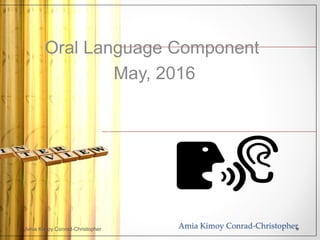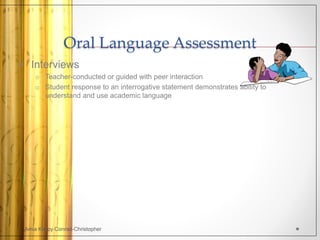Teaching Oral Skills
- 1. Amia Kimoy Conrad-Christopher Oral Language Component May, 2016 Amia Kimoy Conrad-Christopher
- 2. Oral Language Assessment ? Interviews o Teacher-conducted or guided with peer interaction o Student response to an interrogative statement demonstrates ability to understand and use academic language Amia Kimoy Conrad-Christopher
- 3. The purpose of the exam ? The oral exam is a 5-10 minute conversational interchange between the student and the examiner. ? The exam tests studentsĄŊ competencies in the use of Standard English. Amia Kimoy Conrad-Christopher
- 4. The purpose of the exam ? It tests the studentĄŊs receptive language. ? Many students have trouble mastering the structures of oral English, which inhibits their ability to listen, speak, read, and write effectively. Amia Kimoy Conrad-Christopher
- 5. Why assess oral language? ? Assessment of oral language focuses on a studentĄŊs ability to interpret and convey meaning for authentic purposes in interactive contexts (OĄŊMalley & Pierce, 1996). Amia Kimoy Conrad-Christopher
- 6. Why assess oral language? English language learners use language functions to express meaning. Language functions. Communicative language functions. Academic language functions. Amia Kimoy Conrad-Christopher
- 7. Why assess oral language? ? Students need to develop competencies in the accurate use of Standard English: ? Syntax ? Morphology ? Expression ? The knowledge that language is used for different purposes and in different contexts Amia Kimoy Conrad-Christopher
- 8. Why Oral Language? ? Many students commence school with low levels of oral language ? Because it provides the foundation of reading and writing, it is vital that teachers give close attention to oral language and adjust their instructional language and teaching approaches to get all students to high levels of understanding language use. Amia Kimoy Conrad-Christopher
- 9. Oral Language: A Missing Link to Reading Success Amia Kimoy Conrad-Christopher
- 10. Oral language ĻC the key to develop effective communication. Effective communication can be achieved by focusing on activities based on purposeful language interactions. Purposeful talk is one of the major means through which students construct and refine their understandings of language. Talk should underpin all language activities. (First Steps 1997) Amia Kimoy Conrad-Christopher
- 11. What about Creole? ? The use of Creole although accepted and valued by all citizens is not being assessed. ? Being communicatively competent entails being able to adjust oneĄŊs language to specific audiences and situations. Amia Kimoy Conrad-Christopher
- 12. What about Creole? ? Standard English is the cultural capital through which our students must learn to use to negotiate with text and the social environment. ? Can be used in expressions (idioms) Amia Kimoy Conrad-Christopher
- 13. How do we teach Oracy? Amia Kimoy Conrad-Christopher
- 20. Understanding Descriptors Makes an Attempt (1-2) ? Unable to satisfy routine social demands. Often repeats the question and adds non-information. ? Vocabulary is repetitive or limited to yes/no with no articulation of ideas or very limited in scope. Amia Kimoy Conrad-Christopher
- 21. Understanding Descriptors Makes an Attempt (3-4) ? Unable to satisfy routine social demands. Often repeats the question but adds little information. ? Vocabulary is repetitive or limited to yes/no with no articulation of ideas or very limited in scope. Attempts to express/articulate with much support from examiner. Amia Kimoy Conrad-Christopher
- 22. Understanding Descriptors Emerging (5-6) Able to satisfy routine social demands. Answers questions but requires much interpretation by examiner. Attempts to use standard English Amia Kimoy Conrad-Christopher
- 23. Understanding Descriptors Emerging (7-8) Able to satisfy routine social demands. Answers/interprets questions well but uses predominantly Creole. Amia Kimoy Conrad-Christopher
- 24. Understanding Descriptors Satisfactory (9-10) Able to speak the language with sufficient structural accuracy and vocabulary to participate effectively in most formal and informal conversations on practical and social contexts. Amia Kimoy Conrad-Christopher
- 25. Understanding Descriptors Competent (11-13) Able to use the language fluently and accurately on all levels normally pertinent to social and practical contexts. Amia Kimoy Conrad-Christopher
- 26. Understanding Descriptors Superior (14-15) ? Standard English speaking proficiency is functionally equivalent to a well (highly) articulated speech of a Trinidad and Tobago native speaker and reflects the cultural standards of the country. ? (Form three) Amia Kimoy Conrad-Christopher
- 27. Glossary of Terms rubric interpretationassessment Amia Kimoy Conrad-Christopher
- 28. Using the rubric ? The objective of the assessment is to test studentsĄŊ ability to use Standard English. ? Use the key words in the glossary to guide scoring and interpret meaning. ? Score according to the criteria. Amia Kimoy Conrad-Christopher
- 29. Differentiating within a band o Use the studentĄŊs use of Standard English as the key determining factor in differentiating within a band. o Vocabulary o Articulation/Enunciation/Expression Amia Kimoy Conrad-Christopher
- 30. During the interview ? Inform students that the interview is formal. ? Limit your use of Creole (rephrase-translate into Standard English) ? Clarify questions or vocabulary. ? Wait Time Amia Kimoy Conrad-Christopher
- 31. During the interview ? Limit your interpretation of the question or rephrasing ? Use the rubric to score ? Personal Judgement Amia Kimoy Conrad-Christopher
- 32. Oral Language Assessment in the classroom. ? Retelling o Measures studentsĄŊ integrated comprehension though four skills ? Teachers should: o Be explicit about the criteria for evaluation o Use modeling by stronger students o Minimize anxiety which could impact performance Amia Kimoy Conrad-Christopher
- 33. Thank You Amia Kimoy Conrad-Christopher
































